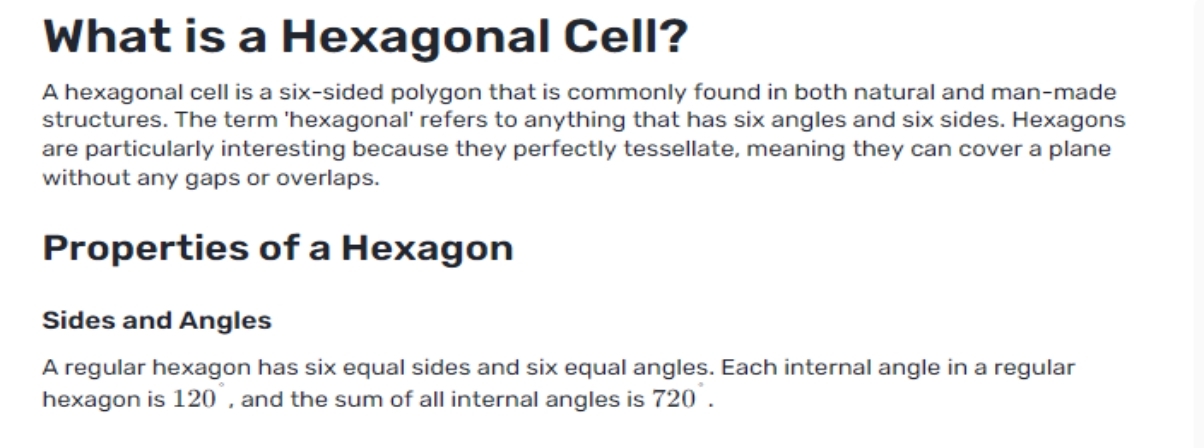Have you anytime contemplated the diverse numerical models found in nature? One such model is the hexagonal cell, a typical shape found in organic entities like bee colonies and snowflakes. The mathematical design of a hexagonal cell is portrayed by its six sides of equivalent length and its six points of 120 degrees each.
This extraordinary shape takes into consideration the proficient pressing of cells and a solid, stable construction. According to a numerical viewpoint, the Hexagonal Cell can be characterized using calculation and geometry. By looking at the connections between the points and sides of the hexagon, mathematicians can determine recipes to depict its shape precisely.
Geometric Structure of a Hexagonal Cell
Hexagons are captivating shapes tracked down all through nature, from the honeycomb of a colony of bees to the cells in a nearby pressed game plan in a precious stone cross-section. At the point when these hexagons are organized in a rehashing design, they structure what is known as a hexagonal cell. The mathematical design of a hexagonal cell is characterized by its essential unit: the hexagon.
A hexagon is a six-sided polygon with straight sides, where each point is estimated at 120 degrees. This standard hexagon fills in as the structure block for the hexagonal cell, as it rehashes in a lattice like style to make a bigger construction. In a hexagonal cell, every hexagon is associated with six different hexagons.
This makes a firmly pressed plan where no space is squandered, making it a proficient design for expanding the utilization of room. The nearness of adjoining cells takes into serious areas of strength for consideration to frame between them, giving the general construction soundness and strength.
By appointing directions to the vertices of every hexagon and characterizing vectors between adjoining vertices, we can portray the spatial connections between the hexagons in the cell. These numerical portrayals assist us with understanding how the hexagons are associated and the way that they rehash to shape the bigger construction of the hexagonal cell.
Defining Hexagonal Cell Mathematically
These factors show how hexagonal cells can be defined mathematically:
Hexagon Shape
At its centre, a hexagonal cell is a six-sided polygon with six points and six vertices. Each point of a standard hexagon is estimated at 120 degrees, making it a balanced shape. This implies that every one of the sides of a hexagon is of equivalent length, and every one of the points is equivalent too.
Side Length
In numerical terms, the side length of a hexagon is meant by the letter 's'. For a normal hexagon, every one of the six sides will have a similar length 's'. The side length assumes a critical part in deciding the general size and extent of a hexagonal cell.
Area
The region of a normal hexagon can be determined utilizing the recipe: Region = (3√3 * s^2)/2. This recipe considers the side lengths 's' of the hexagon and registers the all-out region encased inside its six sides. Understanding the region of a hexagon is significant for different applications in calculation and design.
Perimeter
The border of an ordinary hexagon can be determined by duplicating the side length 's' by six, as all sides of a hexagon are equivalent long. The equation for the border is Edge = 6s. This estimation is key in deciding the complete distance around the hexagon.
Steps to Involve Gauth in Tackling Queries
In the event that you're hoping to tackle questions utilizing Gauth, which is an integral asset for producing and overseeing secure one-time passwords, there are a couple of straightforward advances you can follow to capitalize on it.

Step 1: Enter Your Query
As a matter of some importance, when you have an inquiry you want assistance with, you'll need to enter it into the pursuit bar on Gauth. This could be a particular inquiry concerning a secret key, a security issue you're confronting, or whatever else connected with validation and online security. The hunt bar is your passage to finding the data you want to tackle your question.
Step 2: Get Results
Whenever you've entered your question into the hunt bar, hit enter to come by your outcomes. Gauth will then, at that point, show significant data connected with your inquiry, furnishing you with the responses or arrangements you're searching for. Carve out the opportunity to painstakingly audit the outcomes and check whether they address your inquiry really.
Step 3: Review the Results
Assuming you find that the outcomes given by Gauth don't completely answer your question, simply sit back and relax. You have the choice to regenerate the outcomes by tapping on the fitting button. This will provoke Gauth to give you another arrangement of results, allowing you one more opportunity to find the data you want.
Sum Up
The mathematical design of a hexagonal cell is characterized by its six equivalent sides and six equivalent points, which make a balanced and outwardly engaging shape. Numerically, a hexagon can be characterized as a polygon with six sides, where every inside point is estimated at 120 degrees. Understanding the mathematical properties of a hexagonal cell can give significant bits of knowledge into its primary respectability and possible purposes in different fields like design, science, and design.


